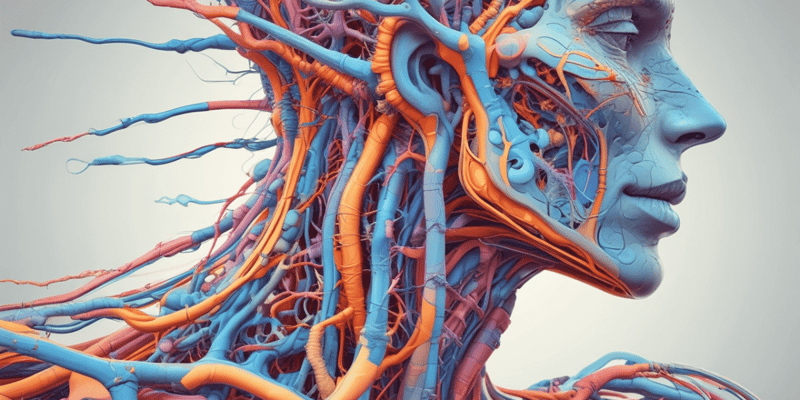Questions and Answers
How do hormones exert their effects on target cells?
By binding to specific receptors and altering gene expression or cellular metabolism
Which axis helps animals respond to stress by coordinating growth, metabolism, and immune function?
Hypothalamic-pituitary-adrenal (HPA) axis
Which hormone plays a crucial role in seed dormancy, stomatal closure, and stress response in plants?
Abscisic acid
What is the main function of cytokinins in plants?
Signup and view all the answers
What is the role of the circadian clock in plants?
Signup and view all the answers
Which system in animals is responsible for processing sensory information and sending signals to effector organs to respond accordingly?
Signup and view all the answers
What is the primary role of the endocrine system in animals?
Signup and view all the answers
Which part of the nervous system is made up of nerves that transmit information between the CNS and the organs, glands, and muscles?
Signup and view all the answers
What is the function of hormones in living organisms?
Signup and view all the answers
How do plants coordinate through control systems?
Signup and view all the answers
Study Notes
Control and Coordination: Exploring Multiple Systems
Control and coordination are essential processes that allow living organisms to maintain homeostasis and adapt to their environment. This complex orchestra is carried out by various systems in both plants and animals. In this article, we'll delve into the role of the nervous system, endocrine system, and hormones in animals, and explore how plants coordinate through control systems and hormonal coordination.
The Nervous System
The nervous system is a communication network of specialized cells called neurons that transmit information to and from different parts of an organism. It is primarily responsible for controlling and coordinating the body's functions by processing sensory information and sending signals to effector organs to respond accordingly. The nervous system consists of the central nervous system (CNS) and the peripheral nervous system (PNS).
The CNS includes the brain and spinal cord, while the PNS is made up of nerves that transmit information between the CNS and the organs, glands, and muscles. Through reflexes and complex neural pathways, the nervous system allows animals to react to their environment, maintain balance, and execute voluntary actions.
The Endocrine System
The endocrine system consists of glands that produce, store, and secrete hormones, chemical messengers that regulate various physiological processes and maintain homeostasis. Hormones exert their effects by binding to specific receptors on target cells, altering gene expression or cellular metabolism.
Hormonal regulation is crucial for coordinating growth, metabolism, reproduction, and stress response in animals. For example, insulin helps regulate glucose levels in the blood, while thyroid hormones influence the metabolic rate. The endocrine system also plays a role in control and coordination through the hypothalamic-pituitary-adrenal (HPA) axis, which helps the body respond to stress.
Hormonal Coordination
Hormonal coordination is the process by which hormones from different glands interact and regulate various physiological processes. Some examples of hormonal coordination include:
- The HPA axis, which regulates stress response, metabolism, and immune function.
- The hypothalamic-pituitary-gonadal (HPG) axis, which coordinates sexual development and reproduction.
- The hypothalamic-pituitary-thyroid (HPT) axis, which regulates metabolism, growth, and development.
Control Systems in Plants
Plants lack a centralized nervous system and hormones that function like animal hormones. However, they have their own control systems and hormonal coordination mechanisms. Some examples include:
- Auxins, which regulate plant growth, cell elongation, and apical dominance.
- Cytokinins, which promote cell division and differentiation, regulating growth and development.
- Abscisic acid, which plays a crucial role in seed dormancy, stomatal closure, and stress response.
- Gibberellins, which regulate seed germination, stem elongation, and flowering.
Plants also have a circadian clock, a biological clock that regulates their daily rhythms and helps them adapt to environmental cycles such as light and temperature.
Hormonal Coordination in Plants
Hormonal coordination in plants is an essential mechanism to regulate growth and development, stress response, and adaptation to environmental conditions. Some examples of hormonal coordination in plants include:
- Auxins, cytokinins, and gibberellins that work together to regulate plant growth and development.
- Abscisic acid and ethylene that interact to regulate seed dormancy, stomatal closure, and stress response.
Conclusion
The control and coordination of living organisms is a complex process involving multiple systems. The nervous system and endocrine system play crucial roles in animals, while plants have their own control systems and hormonal coordination mechanisms. By understanding these processes, we gain insight into how organisms function, adapt, and thrive in their environments.
References:
- Smith, C. M., & Meisami, A. (2007). An introduction to the nervous system. In The nervous system (pp. 1-76). Academic Press.
- Stratton, G. E. (2011). The endocrine system. In The endocrine system (pp. 1-54). Academic Press.
- Córdoba, J. I., & Rontein, P. (2000). Plant signaling molecules: plant hormones as developmental regulators. Current Opinion in Plant Biology, 3(2), 228-233.
- Delker, T. J., & Green, K. M. (2010). Plant hormones: control and coordination of plant growth and development. Annual Review of Plant Biology, 61, 117-140.
Studying That Suits You
Use AI to generate personalized quizzes and flashcards to suit your learning preferences.
Description
Explore the intricate mechanisms of control and coordination in living organisms through the nervous system, endocrine system, and hormonal coordination. Learn how animals rely on specialized neurons and hormones to regulate bodily functions, while plants utilize unique control systems and hormonal mechanisms to adapt to their environment.




